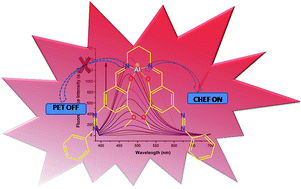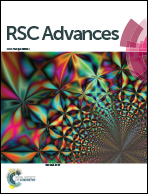A robust fluorescent chemosensor for aluminium ion detection based on a Schiff base ligand with an azo arm and application in a molecular logic gate†
Abstract
In this present work we have reported the synthesis and structural characterisations of a N2O2 donor Schiff base chemosensor with an azo arm (H2L). Various spectroscopic tools like single crystal X-ray, NMR, UV-vis, FTIR, ESI-mass spectrometry etc. have been deployed to develop the present work. In recent years a number of azo derived chemosensors have been reported by different research groups. This is first time we are reporting the design and properties of an azo derived chemosensor (H2L) for the detection of aluminium ions in semi aqueous medium. It has been found that it selectively senses Al3+ ions in semi aqueous solution. Here, the sensing process is mainly based on a chelation enhanced fluorescence process (CHEF). It has very high selectivity over other metal ions and anions. A detailed literature survey has been carried out and compared with this work. It has an appreciably low detection limit i.e. 6.93 nM. 1H NMR titration was carried out to support the plausible complexation process. 1 : 1 stoichiometry binding between the chemosensor and Al3+ ions has been confirmed from Job's plot. An inhibition molecular logic gate has been constructed using chemosensor (H2L), where Al3+ and EDTA act as inputs and fluorescence emission is the output. The structural and electronic parameters of the chemosensor (H2L) and complex [AL(L)]NO3 have been studied in detail using theoretical tools like DFT and TDDFT.


 Please wait while we load your content...
Please wait while we load your content...